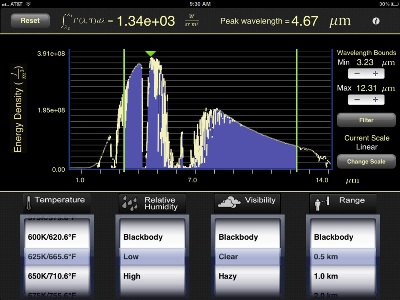Oct 11 2012
Understanding the phenomenon of blackbody radiation – electromagnetic emissions that play a role in a broad range of physical systems – is an important part of physics instruction at both the high school and college level.
 New iPad Application Illustrates the Concept of Blackbody Radiation
New iPad Application Illustrates the Concept of Blackbody Radiation
Thanks to researchers at the Georgia Tech Research Institute (GTRI), explaining this to students just became a little easier.
The observed frequency and intensity of blackbody radiation is affected by interaction between temperature, humidity, distance from the radiating object and other parameters. Traditional textbooks rely on a series of charts to show how these variables affect the emissions, making the concept potentially difficult to understand.
Researchers have now created an iPad application that illustrates the relationship between these parameters, allowing students to explore the interactions and visually determine the impacts of changes. Known as iBlackbody, the application was originally produced as part of a handbook for electro-optical engineers, who must understand the impact of blackbody radiation in their defense and atmospheric sensing research. The program has since been made available to educators and students.
“We have built a tool that allows users to experiment with these parameters to see how the blackbody curve changes based on temperature, humidity, haze conditions, distance and other factors,” said Leanne West, a principal research scientist at GTRI. “The program puts the equations into action so you can see the results from changing variables.”
Using sliders on the screen, users can change the parameters in discrete values that are programmed into the application. For instance, the application allows users to see the impact of temperatures as low as minus 333 degrees Fahrenheit, and as high as 10,340 degrees Fahrenheit.
Available in the iTunes store, iBlackbody is the first iPad application to illustrate the concept of blackbody radiation. It is part of a series of programs and games that GTRI scientists and K-12 education specialists are developing to illustrate science and technology topics that can be difficult to understand using traditional teaching methods.
“We think this is a much better learning tool for anyone attempting to understand blackbody radiation,” said West, a former high school physics and physical sciences teacher. “Using the iPad can really help to bring concepts to life for students and anyone else interested in this topic. Seeing how equations change as input variables change aids in the understanding of the equation and what it is trying to tell you.”
Funds generated by the sale of the app – which is available for 99 cents – will go back into improving it and building other iPad programs, West added. The app was written primarily by Brian Parise, a GTRI research scientist.
The project was supported by SENSIAC, the military sensing organization based at Georgia Tech. The iBlackbody application was originally produced as part of a project converting a traditional handbook on infrared radiation into an electronic book. The application replaces text and a series of charts in the first chapter of the handbook.
“People enjoyed using this application and the saw its potential beyond the handbook,” said West. “What was meant to be just a module within the e-book turned into its own iTunes application.”
Blackbody radiation has a characteristic and continuous frequency spectrum that depends on the temperature of the object emitting it, a phenomenon described mathematically by Planck’s radiation law. The spectrum shifts to higher frequencies as the temperature of the object increases. At room temperature, most of the emissions from a blackbody are in the infrared region, which is not visible to the human eye, which is why the object appears to be black. At higher temperatures, blackbodies can produce visible emissions that range in color from red to blue-white.
A blackbody absorbs all of the electromagnetic energy that it encounters, and then emits it back into the environment. When a blackbody is at a uniform temperature, its emissions have a characteristic frequency distribution that depends on the temperature.
For the future, West hopes to produce other iPad applications, as well as games, intended to teach physics principles.
“Tablet computers are becoming important teaching tools that are playing a larger and larger role in education,” she added. “We want to contribute to future generations understanding the science and engineering concepts that are important to the research we do.”